Accepted Scientific Name: Cyrtostachys renda Blume
Bull. Sci. Phys. Nat. Néerl. 1: 66 (1838)

Bentinckia renda (Cyrtostachys renda) Photo by: Forest Starr & Kim Starr
Habit at Lahaina, Maui, Hawaii (USA). July 13, 2009.
Origin and Habitat: South-east Asia (Peninsular Malaysia, peninsula Thailand, Indonesia, Borneo, Brunei, New Guinea and the island of Sumatra), Australia (Indian Ocean offshore islands, Christmas Island Group ) but has been introduced to other tropical areas of the world where it is cultivated as an ornamental palm.
Habitat: It is found in lowland coastal peat swamps, in wet woods by tidal rivers, in riverbanks and or in lowland rainforests up to 125 (500?) m elevation. Peat swamps are forests that have a layer of peat formation that can range from 0,5-1,5 m in depth. This species grows in forest adjacent to seasonally waterlogged habitats and does not tolerate long-term inundation.
Synonyms:
See all synonyms of Cyrtostachys renda
back
Accepted name in llifle Database:Cyrtostachys renda BlumeBull. Sci. Phys. Nat. Néerl. 1: 66 (1838)Synonymy: 9
back
Common Names include:
ENGLISH: Rajah wax palm, Maharajah palm, Red candle-wax palm, Sumatra wax palm, Sealing-wax palm, Red sealing wax palm, Lipstick palm
CHINESE (中文): 紅椰子
FRENCH (Français): Palmier rouge
HUNGARIAN (Magyar): Pecsétviaszpálma
INDONESIAN (Bahasa Indonesia): Palem merah
MALAY (بهاس ملاي /Bahasa Melayu ): Pinang raja
SPANISH (Español): Palma de tallo rojo, Palma lacre, Palma roja
THAI (ภาษาไทย): หมากแดง
Description: Cyrtostachys rendaSN|24386]]SN|24386]] is a small to medium sized clumping palm to 9 m of height (occasionally up to 20 m) in its native range, often only to 3-5 m elsewhere, It is a spectacular plant, with vivid red crownshaft, and petioles, making it instantly recognizable from other palms. It is a suckering palm and makes a elegant colourful erect clump. It is undoubtedly one of the most beautiful palm in the world.
Stems: Clustered from the base, slender, erect, prominently ringed, spineless, brightened by vivid scarlet leaves sheaths. The stem usually is less than 10 m tall and 4-10(-15) cm in diameter.
Leaves: Pinnate (Feather-shaped) stiffly erect, broad and arched, up to 1,5 m long,
Leaflets 50-80 narrow; slender and 50-60 cm long with strong midrib and veins, rich green, glaucous beneath. regularly arranged and spreading in the some plane, young leaves often reddish. Petiole, very short, 18 cm long; bright scarlet. Leafbases, which form crownshaft, are about 60 cm long and scarlet-tinged.
Inflorescences/Flowers: This is a monoecious palm producing small panicles below the crown of leaves , the flowers come in groups of three, one female flanked by two males.
Fruit: Ellipsoid to ovoid about 8-10 x 4-6 mm, with a narrowed top, black with a scarlet base when mature.
Seed: Ovoid to round, 7-9 mm long.
Bibliography: Major references ans further lectures
1) Forest & Kim Starr Cyrtostachys renda (Sealing wax palm). Plants of Hawaii. <http://www.starrenvironmental.com>. Downloaded on 21 August 2014.
2) Don Ellison, Anthony Ellison “Cultivated Palms Of The World” UNSW Press, 01/May/2001
3) Robert Lee Riffle, Paul Craft “An Encyclopedia of Cultivated Palms” Timber Press, Portland 2007
4) John Dransfield, Natalie W. Uhl, Conny B. Asmussen, William J. Baker, Madeline M. Harley, Carl E. Lewis: “Genera Palmarum. The Evolution and Classification of Palms.” Royal Botanic Gardens, Kew 2008
6) Jones, David L. "Palms throughout the world." Washington, DC: Smithsonian Institution Press. 1995
7) Heatubun, Charlie D.; Baker, William J.; Mogea, Johanis P.; Harley, Madeline M.; Tjitrosoedirdjo, Sri S.; Dransfield, John (March 2009). "A monograph of Cyrtostachys (Arecaceae)". Kew Bulletin (Royal Botanic Gardens, Kew) 64 (1): 67–94.
8) Wikipedia contributors. "Cyrtostachys renda." Wikipedia, The Free Encyclopedia. Wikipedia, The Free Encyclopedia, 21 Aug. 2014. Web. 26 Aug. 2014
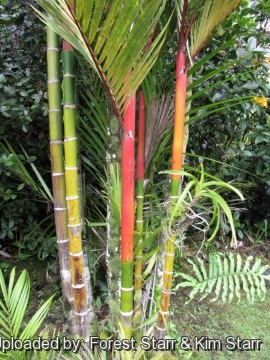 Habit at Panaewa Zoo, Hawaii. July 16, 2012. (Cyrtostachys renda) Photo by: Forest Starr & Kim Starr
Habit at Panaewa Zoo, Hawaii. July 16, 2012. (Cyrtostachys renda) Photo by: Forest Starr & Kim Starr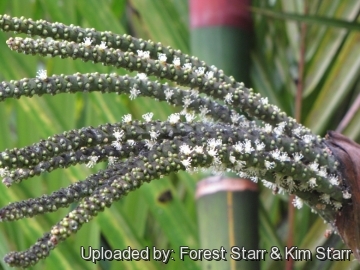 Flowers at Panaewa Zoo, Hawaii. July 16, 2012. (Cyrtostachys renda) Photo by: Forest Starr & Kim Starr
Flowers at Panaewa Zoo, Hawaii. July 16, 2012. (Cyrtostachys renda) Photo by: Forest Starr & Kim Starr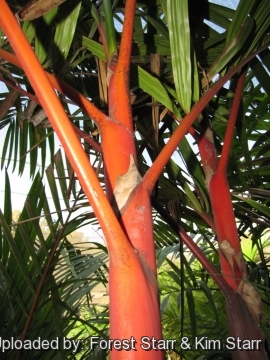 Colored trunk at Resort Management Group Nursery Kihei, Maui, Hawaii (USA). February 09, 2011. (Cyrtostachys renda) Photo by: Forest Starr & Kim Starr
Colored trunk at Resort Management Group Nursery Kihei, Maui, Hawaii (USA). February 09, 2011. (Cyrtostachys renda) Photo by: Forest Starr & Kim Starr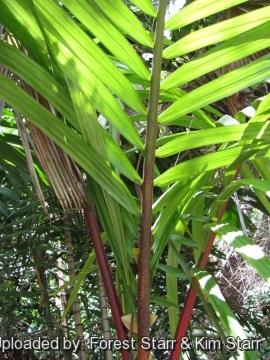 Fronds at Iao Tropical Gardens of Maui, Maui, Hawaii (USA). May 22, 2012. (Cyrtostachys renda) Photo by: Forest Starr & Kim Starr
Fronds at Iao Tropical Gardens of Maui, Maui, Hawaii (USA). May 22, 2012. (Cyrtostachys renda) Photo by: Forest Starr & Kim Starr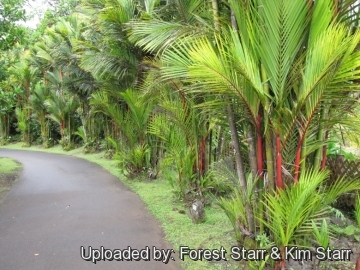 Habit at Panaewa Zoo, Hawaii, Hawaii (USA). July 16, 2012. (Cyrtostachys renda) Photo by: Forest Starr & Kim Starr
Habit at Panaewa Zoo, Hawaii, Hawaii (USA). July 16, 2012. (Cyrtostachys renda) Photo by: Forest Starr & Kim Starr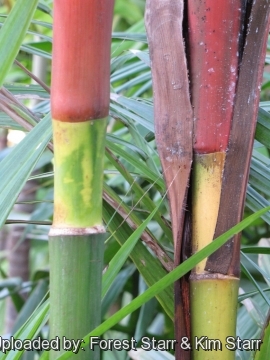 Colored trunk at Resort Management Group Nursery Kihei, Maui, Hawaii (USA). February 09, 2011. (Cyrtostachys renda) Photo by: Forest Starr & Kim Starr
Colored trunk at Resort Management Group Nursery Kihei, Maui, Hawaii (USA). February 09, 2011. (Cyrtostachys renda) Photo by: Forest Starr & Kim Starr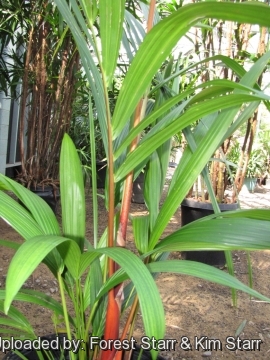 Habit at KiHana Nursery Kihei, Maui, Hawaii (USA). February 15, 2011. (Cyrtostachys renda) Photo by: Forest Starr & Kim Starr
Habit at KiHana Nursery Kihei, Maui, Hawaii (USA). February 15, 2011. (Cyrtostachys renda) Photo by: Forest Starr & Kim StarrSend a photo of this plant.The gallery now contains thousands of pictures, however it is possible to do even more. We are, of course, seeking photos of species not yet shown in the gallery but not only that, we are also looking for better pictures than those already present.
Read More... Cultivation and Propagation: This beautiful palm is often grown in tropical regions for its pretty red colour, but unfortunately it is virtually ungrowable outside the tropics. It is a relatively tricky, slow-growing plant that needs high humidity, well-drained soil, and is not tolerant of drought or wind. It's definitely worth an effort to grow this beauty! It lives also well under home conditions.
Soil requirements: It prefers rich, moist, loamy, slightly acidic, soils except those that are constantly soggy.
Watering: It prefers moist soils (not saturated) and require plenty of water at all times. As they naturally grow in swamps, they are highly tolerant of flooding, but don't let sit in standing water for prolonged periods.
Light: It adapts well to full sun or part shade. If home-grown, this palm will require a good overhead light and some sun as with most tropical palms.
Fertilization: Need a perfect fertilizer diet including all micro nutrients and trace elements. Micronutrient deficiencies are occasional problems. Micronutrient deficiencies only show up on soil with a high pH.
Aerosol salt tolerance: It is moderately salt tolerant, but does a lot better inland then it does on the coast.
Hardiness: This palm is extremely cold sensitive and need constant warmth. Any temperature drop below about 15° C is usually fatal. Ideal year-round temperatures range from 24° to 30° C. (USDA Zones 12).
Wind hardiness: It cannot tolerate sweltering heat and windy conditions.
Maintenance: Prune diseased, damaged or drying fronds, but do not prune if the frond still has some green colour. Palms recycle nutrients from dead or dying fronds and use them for healthier fronds. Palms only have a set number of new leaves that can sprout and grow per year and removing fronds will not increase that number. If you cut off more than what will grow annually, you could be left with a pretty bare and bald Palm.
Use: It is grown as an ornamental plant in gardens. For its dense and clustering growth habit, primarily is used as a shrub, hedge or screen in subtropical or tropical landscapes. It also can be used as a specimen palm to show of its red canes, especially if older leaves are pruned. It also makes a great potted specimen for a patio or inside.
Food Uses: Local communities in Sumatra eat the growing tip of the stem (palm heart).
Disease & Pests: This palm is resistant to major pests and diseases, but may require protection against scale insects, cold weather and spider mites.
Propagation: Fresh seeds are very slow to germinate, from a minimum of 2-3 months to 1 year and the seedlings are attractive. If not properly treated, the seed does not have long shelf life. It produces offsets, and these can be cut off, when mature enough, as a propagation method. For propagation select sturdy, shapely, healthy plant free from insect and disease damage. New leaf growth is desirable.
















